“1983 Conference Slide Set”, 1983
Title:
- 1983 Conference Slide Set
Year:
- 1983
Conference:
Description:
Editors:
Stephen R. Levine
James E. George
Maxine D. Brown
The images in the SIGGRAPH ’83 Conference Slide Set are representative of the most recent technological advances, creative artistry and innovative applications in computer graphics. This collection demonstrates state-of-the-art computer graphics being done by industry, academia and the art world.
All of the images in the SIGGRAPH ’83 Conference Slide Set are marked with a proper copyright notice. These images are not to be further copied or reproduced without the explicit permission of the individual copyright owners.
1 . PETER WATTERBERG, 2644 Sandia National Laboratories, Albuquerque, NM 87185, (505) 844-7196. “SIGGRAPH ’83/Mandrill Title Slide”. The image was generated at a resolution of 819 x 518 using a ray tracing algorithm employing color mapping and texture techniques developed by Jim Blinn. Software was written by Peter Watterberg. Hardware includes a VAX 11/780, Cray-lS, Cyber 76 and Dicomed D48 film recorder.
2 ROB COOK (director), Lucasfilm Ltd., P.O. Box 2009, San Rafael, CA 94912, (415) 499-0239. “Road to Point Reyes”. This landscape was defined using patches, polygons, fractals, particle systems, and a variety of procedural models. The various elements were rendered separately and later composited. Rob Cook designed the picture and did the texturing and shading, including the road, hills, fence, rainbow, shadows and reflections. Loren Carpenter used fractals for the mountains, rock and lake, and a special atmosphere program for the sky and haze. Tom Porter provided the procedurally drawn texture for the hills and wrote the compositing software. Bill Reeves used his particle systems for the grass and wrote the modeling software. David Salesin put the ripples in the puddles. Alvy Ray Smith rendered the forsythia plants using a procedural model. The visible surface software was written by Loren Carpenter, and the anti-aliasing soft- ware by Rob Cook. The picture was rendered using an lkonas graphics processor and frame buffers, and was scanned on a COLOR FIRE 240, courtesy of MacDonald Dettwiler and Associates Ltd. The resolution is 4K x 4K, 24 bits/pixel.
3 LORRAINE PRINCE, Genigraphics, 7711 Rock- hill, Houston, TX 77061, (713) 645-5267 or (713) 524-5673. “Time for Computer Graphics”. This image was produced with simple primitives on a Genigraphics lO0C graphics console running Genigraphics RSX software. The picture was shot using a modified Forox camera at 4096 lines of resolution at f/8 with the neon glow as a separate exposure.
4 GREG LORIO, Rensselaer Polytechnic Institute, Center for Interactive Computer Graphics; cur- rent address: Raster Technologies, 9 Executive Park Dr., N. Billerica, MA 01862, (617) 677-8900. “Martini Glass”. This image was generated on a Prime 500 using a ray tracing package based on the super-quadric primitive. The package sup- ports reflection and refraction. The image was displayed on a model one/20 Raster Technologies graphics system and photographed on a Dunn Instruments camera.
5 ROY HALL, Cornell University, Program of Computer Graphics, 120 Rand Hall, Ithaca, NY 14853, (607) 256-4880. “The Gallery”. Generated using ray tracing methods, this scene features focused light sources and a reflection model that simulates metals. The work was computed at 512 x 512 x 48 bit resolution on a VAX 11/780 and recorded using a Dunn Instruments camera, model 632. Chan Verbeck !ended technical support.
6 BRIAN A. BARSKY, TONY D. DeROSE, MARK D. DIPPE, University of ‘California – Berkeley, College of EngineeriI,1g, Department of Electrical Engineering and Computer Sciences, Computer Graphics Laboratory, 505 Evans Hall, Berkeley, CA .94720, (415) 642-9838. The :scenes were rendered with a fast subdivision algorithm that converts Beta-splines to polygons, on an lkonas RDS-3000 raster display attached to a VAX 11/750 running•Berkeley UNIX. (Note: The Beta-spline is a new mathematical representation explained in Barsky and Beatty’s paper, “Local Control of Bias and Tension in Beta-Splines”, ‘found in the SIGGRAPH ’83 Proceedings.) (6) “Beta-Spline Bottle with Increasing Tension Values and Different Textures”. This array is based on a single Beta-spline bottle with only the ten- sion varying. The tension is increasing from left to right and from top to bottom in an exponential fashion. Each of the tensed bottles has different material characteristics including metallic, dusty and plastic substances. The bias remains fixed throughout.
7 Pacific Data Images, 550 Weddell Drive – Suite 3, ‘Sunnyvale, CA 94086, (408) 745-6755. (7) GLENN ENTIS, “Cat Clock”. The objects in this scene were modeled from anti-aliased polygons. POi’s script system was used to model the objects with various geometric primitives and B-spline based shapes. The 3-dimensional scene was then rendered on a VAX 11/750 at 512 x 486 resolution and matted in the frame buffer over the sunrise sky and wall gradation. Richard Chuang was responsible for the bow-tie and the photo.
8 HITOSHI NISHIMURA, YOSHI FUKUSHI- MA, Osaka University, Computer Graphics Research Center, Department of Electronic Engineering, 2-1, Yamada-Oka, Suita, Osaka, 565 Japan, phone (06) 877-5111. “The Skull from GOLGO 13”. This skull was designed for the animated film GOLGO 13. The picture was generated by a multi-microcomputer system (Links 1) consisting of 64 computers. Modeled by approxi- mately 600 control points, the skull was rendered with a ray tracing algorithm. Toyo Links Cor ·poration produced the still photograph. (Note: For further information on the computer con- figuration used, see “Panel: Japanese Computer Graphics: Challenges and Opportunities, Part I” in the SIGGRAPH ’83 Proceedings.) GOLGO 13 – art direction by Satomi Mikuriya, final design by Shin Matsuoka and final realization by Takashi Fukumoto.
9 RICHARD F. VOSS, IBM Thomas J. Watson Research Center, P.O. Box 218, Yorktown Heights, NY 10598, (914) 945-2855. “Fractal Lunar·Mist”. Exponentially attenuating surface mist, rising above a random cratered non- Gaussian fractal landscape. Fractal characteris- tics according to ”The Fractal Geometry of “Nature” by B. Mandelbrot.(Freeman 1982). The original image was produced· with an IBM 4341 computer and Celco GFR 4000 color film recorder on 4 x 5 Ektachrome.
10 LAURETTA JONES, 315 East 5th St. #3E, New York, NY 10003, (212) 777-3978. (10) “Devil .Chip”. The image was created with an Apple II+ and an Apple graphics tablet. The slide image was processed by Visual Images in Rochester.
11-12 Aydin Controls, 414 Commerce, Dr., ·Fort Washington, PA 19034, (215) 542-7800, contact Johanna M. Manning, Product Promotion Spe- cialist. These application slides are made using Aydin products.
13-14 Ford Motor Company, Scientific Research lab., Mail Stop E-1134, 20000 Rotunda Drive, Dear- born, MI 48121, (313) 337-6453. These images were produced using a Ford enhanced version of PADL2 from the University of Rochester on a VAX 11/780 and rendered on a Raster Technologies Model One display. (13) FRANK BLISS, ALAN CLARK, DIANA MAJCHER, RONALD TEMPLE, DANIEL TOTH, “Motorcraft Spark Plug”, (14) FRANK BLISS, GREGORY BURNETT, ALAN CLARK, .RONALD TEM- PLE, DANIEL TOTH, “Piston Assembly for Ford Escort I 6L Engine”.
15 GUNTER ENDERLE, Kernforschungszentrum Karlsruhe, Weberstrasse 5, D 7500 Karlsruhe 1, Federal Republic of Germany. “Advanced Fusion Reactor Study”. The image was generated using a ray tracing algorithm • Enderle designed and integrated in GIPSY, a 3-D graphics system originally developed by Richard Schuster of BMW, Munich. The objects, part of the Tandem Mirror Fusion Reactor TASKA, were modeled with GIPSY by E.G. Schlechtendahl and K.H. Bechler. The image was produced on an AED 512 color raster terminal connected to an IBM main- frame. The original hardcopy was generated by a Matrix 4000 color camera system on Ektachrome film.
16-18 Los Alamos National Laboratory, Los Alamos, NM 87544. These are MAPPER generated images recorded on an FR80 color film recorder. (16-17) GEORGE TRUJILLO (18) PATRICK HODSON
19-20 CRAIG D. UPSON, Lawrence Livermore National Laboratory, P.O. Box 808, MS L-262, Livermore, CA 94550, (415) 422-1862. These images were recorded on a Dicomed Dl48 recorder. (19) “Bay 14” (20) “Boston”
21-23 ARLENE ACKERMANN, GENE HEATON, LOUISE NELSON, NICK CURTIS, EG&G Idaho, Inc., P.’O. Box 1625, Idaho Falls, Idaho 83415. These slide images were generated at the Idaho National Engineering Laboratory using parallel Cyber 176’s and a Dicomed D148C for hardware and a modified version of Los Alamos National Laboratory’s MAPPER for software.
24 DOUGLAS DIX,ON, SCOTT MARSHALL, MIKE KEITH, RCA. This composition contains 4 Teletext’video magazine pages, 512 x 480 resolution.
25-26 Lexidata Corp., 755 Middlesex Turnpike, Biller- ica, MA 01865, (617) 663-8550, contact Kurt D. Dossin, Marketing Communications: These color images were generated on the Lexidata SOLID- VIEW system at 640 x 512 resolution, 30 Hz inter- laced, using the SDRC GEOMOD solids model- ing application software package. (25) “Universal Joint”. Consists of approxi- mately 3000 polygons. (26) “Ball Bearing Assembly”. Done in translucency mode.
27 Hiroshima University, Electric Machinery Labor- atory, Faculty of Engineering, Saijocho, Higashi- hiroshima, 724 Japan. (27) NAKAME, OKAMURA, NISHITA,. “Lighting Simulation for Interior Design”.
28 DAVE SALESIN, Brown University, Department of Computer Science, current address: Lucasfilm Ltd. (see #2). “Figure-Eight Torus with Six Twists”. The picture was constructed from math- ematical surface and texture definitions and pre- viewed on Lexidata 3400 and Ramtek 9400 graphics systems. The upper part of the figure- eight was rendered as copper; the lower part, obsidian. The programs run on a VAX 11/780 under Berkeley UNIX. The picture was imaged on a Matrix QCR-D2000 film recorder at 2048 x 1360 resolution.
29. RAYMOND GATES, WILLIAM VON OFEN- HEIM, Computer Sciences Corporation, Applied Technology Division, 3217 North Armistead Ave., Hampton, VA 23666, (804) 865-1725. “Space Station (Johnson Model Close-Up)”. Image was produced using MOVIE.BYU and locally developed software resident on a PRIME 750 computer. A Dicomed D47 color film writer was used as the output device. This work was per- formed for the System Experiments Branch of the Space System Division of Langley Research Center by the above CSC personnel under Con- tract Number NASl-16078.
30-32 Raster Technologies, 9 Executive Park Dr., North Billerica, MA 01862, (617) 667-8900. Images were produced on Raster Technologies’ graphics system, resolution 512 x 512 x 24 bits.
33 LAURETTA JONES (see #10); (33) “Etch-A-Sketch With Knot” is created on an Apple II+ using an Apple graphics tablet. The slide was shot directly off a Sony Trinitron monitor.
34 MIMI KOLOMBATOVIC, Scion Corp., 12310 • Pinecrest Rd;, Reston, VA 22091, (703) 476-6100. This art was produced on a MicroAngelo CS5080 color system. The.·software used was an in-house paint/animation paakage.
35 BAR:BARA NESSIM, 80 Varick St., New York, NY 10013, (212) 677-88881 • This image was made using a paint system on a Telidon IPS2.
36 PHILIPPE BERGERON, PIERRE LACHA- PELLE, 3090 Linton #14, Montreal,. Quebec H3S 1S3, Canada, (514) 737-4800. “Bridge,Over Calm Water”. This image was created at the Uni.versity of Montreal using MIRA software (graphical PASCAL extension) on- a Cyber 173 computer, and output to a Tektronix 4027.
37 Aydin Controls, (see #11-12).
38 GEOFFREY GARDNER, Grumman Aerospace Corp·., Research & Development Center, AOl-026,, Bethpage, NY 11714, (516) 575-4791. This scene· demonstrates non-edge ClG techniques developed by, Gardner. The scene was modeled with quadric surfaces bounded1 by planes and overlaid with texture. patterns generated by a mathematical function which modulates surface shading and translucence.
39-40 JENNIFFER JULICH, Sheridan College of Applied Arts and Technology, Trafalgar Rd., Oakville, Ontario L6H 2Ll, Canada, (416) 845-9430. These images were generated on the Genigraphics lOOC design station.
41 RACHEL GELLMAN, 192 Blee·eker St. #21, New York, NY 10012, (212) 505-0155. “Paris Facade”. This image was made using Digital Effects’ Video Palette Paint System.
42 TODD RUNDGREN, Utopia Software, c/o Vec- trix Corp., 1416 Boston Rd., Greensboro, NC 27407. “Light Ball (Witch Picture)”. Th.is image was made using the Vectrix VX384 frame buffer and VXM monitor, an Apple II and the Vec- trix/Utopia Paint System.
43 GERALD WEIL, PAUL STRAUSS, RONEN BARZEL, Brown University, Department of Computer Science, Box 1910, Providence, RI 02912, (401) 863-3300. “Waterscape”. This com- bines fractal mountains with a sky containing randomly placed clouds made up of shaded ellip- soids. The water was generated by mirroring the upper part of the· scene and skewing the scan lines. The image was previewed· on a Lexidata 3400 and imaged on a Matrix QCR-D2000 film recorder at 512 x 512 x 24 resolution, both con- nected to a VAX 11/780 running Berkeley UNIX.
44 JONATHAN KOREIN, LYNNE SHAPIRO, ROBIN PYLE, MARION YAGER, NORMAN BADLER, University of Pennsylvania, Moore School of Electrical Engineering, Department of Computer and Information Science, Phila., PA 19104, (215) 898-8540. “Bubblewoman 83”. This image is made of overlapping spheres projected as disks and was designed and displayed using Uni- versity of Pennsylvania’s sphere editor and ren- dering routines. The background was created and displayed with the MOVIE.BUY polygon model- ing system. The display was made on a Grinnell GMR27 and the picture was photographed using a Matrix 3000 film recorder.
45 Advanced Technology Systems, 17-01 Pollitt Dr., P.O. Box 950, Fair Lawn, NJ 07410, (201) 794-0200. The hardware used includes a VAX 11/780, an Adage/lkonas RDS 3000 (1024 x 1024 x 24 frame buffer) and a Dunn Instruments 632 film recorder. Contour Modeling System (CMS) software was used. (45) DAN STIPE, “Heads”. The head is gener- ated with an anthropometric positioning pro- gram. The columns are cylindrical primitives. The brain is a partially transparent sphere surround- ing a space curve complex.
46 JOHN PETER LEWIS, DUNBAR BIRNIE, MIT, School of Architecture and Planning, Architecture Machine Group, 77 Massachusetts Ave., Cambridge, MA 02139, (617) 253-5960. “Headlines”. The image compares several cri- teria for the Keppel/Fuchs contour-tiling prob- lem. The image was generated on a Perkin Elmer 3220 minicomputer with a Ramtek 640 x 480 x 9 frame buffer.
47 MICHAEL W. VANNIER, Mallinckrodt Insti- tute of Radiology, Washington University School of Medicine, 510 South Kings Highway, St. Louis, MO 63110. Also, J.L. MARSH, Cleft Palate and Craniofacial Deformities Institute, St. Louis Children’s Hospital. “CT Scan”. This image shows the facial features of an adolescent male with a marked congenital facial asymmetry. The cheekbones are dissimilar bilaterally, with gross enlargement of the patient’s right cheek- bone due to polyostotic fibrous dysplasia. The surface reconstructions were computed using a Siemens Somatom 2 CT scanner. This scanner incorporates a PDP 11/34 minicomputer. Color images were formed using a DeAnza Systems model ID-5512/8C display system.
48 RICHARD V. LUNDIN, NYIT, P.O. Box 170, Old Westbury, NY 11568, (516) 686-7644. “Robot in Control Room”.
49-51 Digital Effects Inc., 321 West 44th St., New York, NY 10036, (212) 581-7760. (49) JOE PASQUALE, “Plugmen”. (50) ALAN GREEN, DONALD LEICH, GENE MILLER, “Lumbar Vertebra 1982”. (51) DON LEICH, “Untitled”.
52 MICHAEL BAILEY, BILL CHARLES- WORTH, DAVE PLUNKETT, MARK HENDERSON, CAD LAB, Potter Engineering Center, Purdue University, West Lafayette, IN 47907, (317) 494-5944. “Solid Geometric Model of a Cincinnati Milacron T3-726 Electric Robot” .. Shadow capability was added to the ICEM modeler to produce this image.
53-55 Ohio State University, Computer Graphics Research Group, The Cranston Center, 1501 Neil Ave., Columbus, OH 43201, (614) 422-3416, con- tact Dr. Thomas E. Linehan; Associate Director. All images were generated using in-house soft- ware. They were calculated on a VAX 11/780 and displayed on a 32-bit frame buffer. (53) DOUGLAS KINGSBURY, “Butterflies”. (54) DAVID LISTER, “Bouncing Balls”. (55) JOHN BERTON, “Untitled”.
56 MICHAEL COLLERY, Cranston/Csuri Produc- tions, The Cranston Center, 1501 Neil Ave., Col- umbus, OH 43201, (614) 421-2000. “Vases on the Water”.
57-58 DAVID GORDON, Randall-Gordon Associates, 2208 W. Dravus – Suite 2, Seattle, WA 98199, (206) 285-0805. These images were created with PASCAL software and photographed from a Chromatics CG7900 with 8 bit planes. (57) “SPHPLNl”. (58) “Untitled”.
59 JANUS KEATING, DEC, 700 Huron Ave. #13E, Cambridge, MA 02138, (617) 876-7112. “Inter- connect Strategy”. This image was generated on a Genigraphics system.
60 DAVID KAMINS, Boston University, Academic Computing Center, 111 Cummington St., Boston, MA 02215, (617) 353-2750. This image was produced on an IBM 3081 and photographed using an AED 512 and Matrix 4007.
61 BRIAN A. BARSKY, TONY D. DeROSE, MARK D. DIPPE, (see #6). “Christmas at Macy’s”. Three Beta-spline ornaments: the shape of Christmas future. Two of the objects occur multiply.with 3 different values of tension. The ornaments are constructed from various glossy materials. The bias remains fixed throughout.
62 Genigraphics, P.O. Box 591, Liverpool, NY 13088, contact Janet B. McConnell, Manager Marketing Administration. “Sailboat”. A Geni- graphics lO0C Swiftwriter was used.
63 WADE HOWIE, Genigraphics, c/o Computer Visuals, 417 Queen’s Quay W., Toronto, M5V 1A2, Canada, (416) 362-7633.
64-67 Digital Productions, 3416 S. La Cienega Blvd., Los Angeles, CA 90016, (213) 938-1111. These images were made using Digital Productions’ pro- prietary software on a Cray lS/1300 supercom- puter. (64) “DEVO Hat”. (65) “FUJI Videocassette Box”. (66) “Cray Temple – Aerial View”. (67) “Cray Self-Portrait”.
68 NAK AME, NISHITA, OHBAY ASHI, Hiroshima University (see #27). “Lighting Simulation of a Building”.
69-70 NADIA MAGNENAT-THALMANN (Business School of Montreal), DANIEL THALMANN (University of Montreal), Ecole des Hautes Etudes Commerciales, Universite de Montreal, 5255 Avenue Decelles, Montreal, Quebec H3T 1V6, Canada. Examples using MIRA, a graphical programming language.
71 GEORGE JOBLOVE, DOUG KAY, Marks & Marks Inc., 2690 Beachwood Dr., Los Angeles, CA 90068, (213) 464-6302. “Channel Nine Televi- sion, Australia”. This image is from a 17-second television network identification. Hardware includes a PDP 11/23, Ikonas frame buffer, Dunn camera system, Harrison & Harrison effects filters, and Mitchell 35mm motion picture camera.
72-75 Advanced Technology Systems (see #45). (72) DAN STIPE, “Tanks in Dust Storm”. American M-48 Medium Tanks with shadows in desert sand storm with horizon glow. Visibility attenuation has been depicted here as a sand- storm, partially obscuring the tanks. (73) STAN COHEN, “Yaks at Sea”, Kiev class V /STOL aircraft carrier with deck markings and 5 Yak-36 VTOL aircraft, with sun glint on air- craft canopies, shadows of aircraft, whitecap waves on ocean and horizon glow. (74) STAN COHEN, “Concord’s Inaugural Landing – View 2”. View of Dulles airport’s control tower with Air France’s and British Air- ways’ Concords in the foreground simulating the inaugural landing at the airport. (75) STAN COHEN, “Toroids Over Linoleum with Shadow”. Geometric torus is generated pro- grammatically. Interlocking tori are positioned in 3-space over a pattern with a vertex sun glint applied.
76-78 Pacific Data Images, (see #7). (76) GLENN ENTIS, “Artist’s Table”. (77) RICHARD CHUANG, “Sword in the Forest”. (78) CARL ROSENDAHL, “SIGGRAPH ’83”.
Publication Documents:
1983 Conference Slide Set Images:
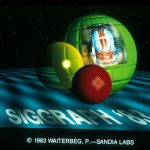
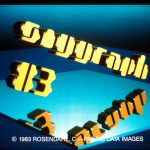
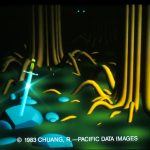
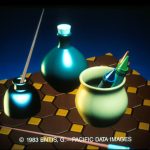
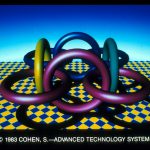
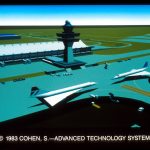
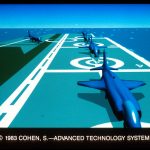
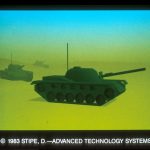
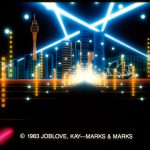
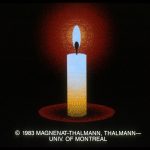
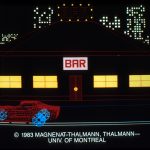
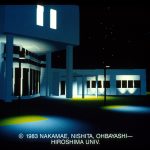
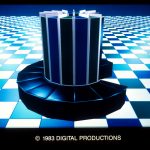
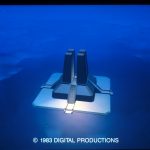
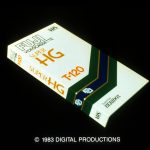
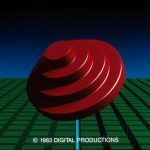
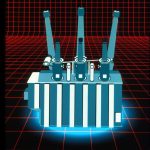
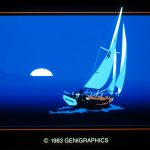
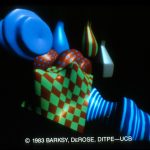
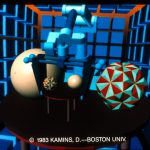
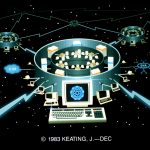
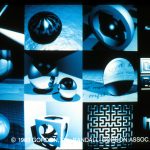
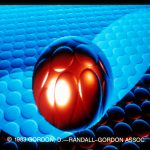
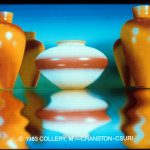
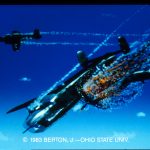
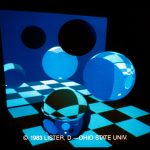
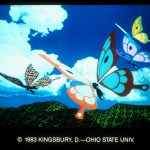
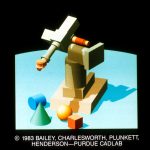
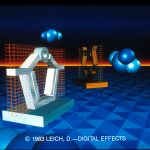
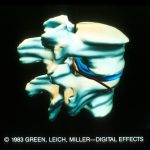
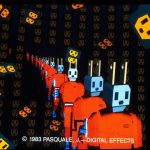
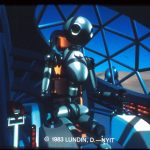
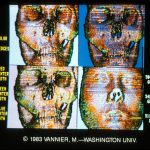
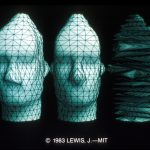
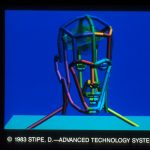
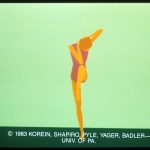
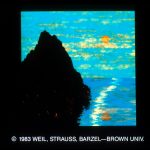
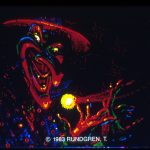
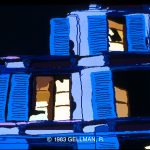
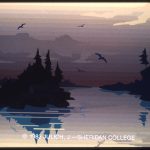
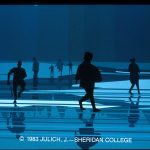
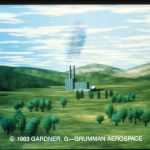
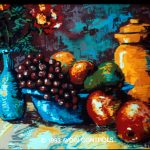
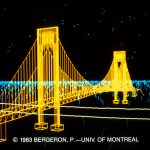
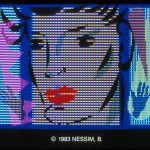
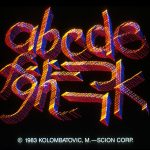
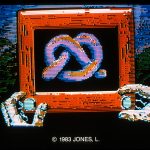
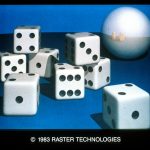
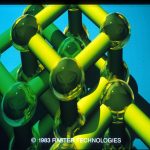
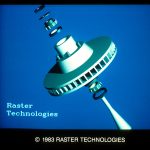
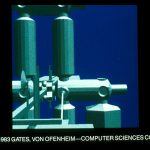
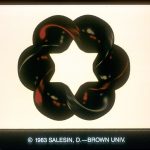
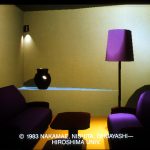
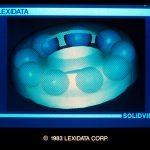
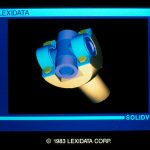
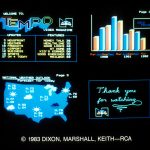
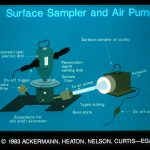
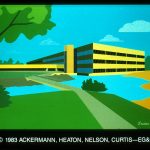
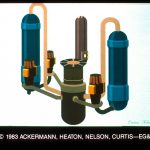
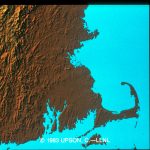
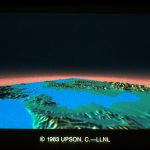
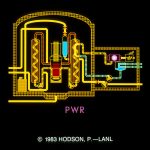
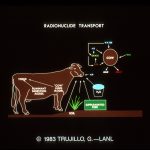
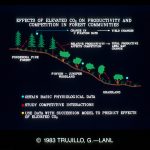
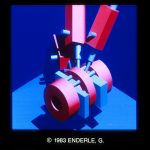
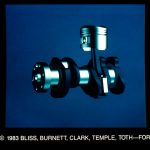
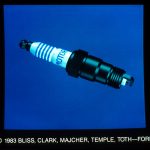
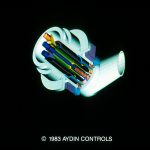
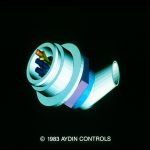
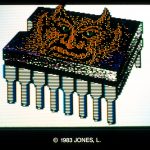
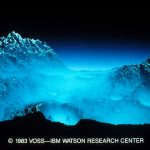
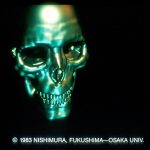
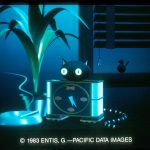
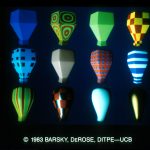
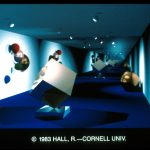
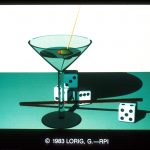
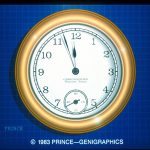
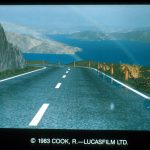
Additional Information:
- PETER WATERBERG, 2644 Sandia National Laboratories, Albuquerque, NM 87185, (505) 844-7196. “SIGGRAPH ’83/Mandrill Title Slide”. The image was generated at a resolution of 819 x 518 using a ray tracing algorithm employing color mapping and texture techniques developed by Jim Blinn. Software was written by Peter Watterberg. Hardware includes a VAX 11/780,Cray-IS, Cyber 76 and Dicomed D48 film recorder.
- ROB COOK (director), Lucasfilm Ltd., P.O. Box 2009, San Rafael, CA 94912, (415) 499-0239. “Road to Point Reyes”. This landscape was defined using patches, polygons, fractals, particle systems, and a variety of procedural models. The various elements were rendered separately and later composited. Rob Cook designed the picture and did the texturing and shading, including the road, hills, fence, rainbow, shadows and reflections. Loren Carpenter used fractals for the mountains, rock and lake, and a special atmosphere program for the sky and haze. Tom Porter provided the procedurally drawn texture for the
hills and wrote the compositing software. Bill Reeves used his particle systems for the grass and wrote the modeling software. David Salesin put the ripples in the puddles. Alvy Ray Smith rendered the forsythia plants using a procedural
model. The visible surface software was written by Loren Carpenter, and the anti-aliasing software by Rob Cook. The picture was rendered using an Ikonas graphics processor and frame buffers, and was scanned on a COLOR FIRE 240, courtesy of MacDonald Dettwiler and Associates Ltd. The resolution is 4K x 4K, 24 bits/pixel. - LORRAINE PRINCE, Genigraphics, 7711 Rockhill, Houston, TX 77061, (713) 645-5267 or (713) 524-5673. “Time for Computer Graphics”. This image was produced with simple primitives on a Genigraphics lOOC graphics console running Genigraphics RSX software. The picture was shot using a modified Forox camera at 4096 lines of resolution at f/8 with the neon glow as a separate
exposure. - GREG LORIO, Rensselaer Polytechnic Institute, Center for Interactive Computer Graphics; current address: Raster Technologies, 9 Executive Park Dr., N. Billerica, MA 01862, (617) 677-8900. “Martini Glass”. This image was generated on a Prime 500 using a ray tracing package based on the super-quadric primitive. The package supports reflection and refraction. The image was displayed on a model one/20 Raster Technologies graphics system and photographed on a Dunn Instruments camera.
- S ROY HALL, Cornell University, Program of Computer Graphics, 120 Rand Hall, Ithaca, NY 14853, (607) 256-4880. “The Gallery”. Generated using ray tracing methods, this scene features focused light sources and a reflection model that simulates metals. The work was computed at 512 x 512 x 48 bit resolution·on a VAX 11/780 and recorded using a Dunn Instruments camera, model 632. Chan Verbeck lended technical support.
- BRIAN A. BARSKY, TONY D. DeROSE, MARK D. DIPPE, University of California – Berkeley, College of Engineering, Department of Electrical Engineering and Computer Sciences, Computer Graphics Laboratory, SOS Evans Hall, Berkeley, CA 94720, (415) 642-9838. The ·scenes were rendered with a fast subdivision algorithm that converts Beta-splines to polygons, on an • Ikonas RDS-3000 raster display attached to a VAX 11/750 running Berkeley UNIX. (Note: The Beta-spline is a new mathematical representation explained in Barsky .and Beatty’s paper, “Local Control of Bias and Tension in Beta-Splines”, found in the SIGORAPH ’83 Proceedings.) “Beta-Spline Bottle with Increasing Tension Values and Different Textures”. This array is based on a single Beta-spline bottle with only the tension varying. The tension is increasing from left to right and from top to bottom in an exponential fashion. Each of the-tensed bottles has different material characteristics including metallic, dusty and plastic substances. The bias remains fixed throughout.
- Pacific Data Images, 550 Weddell Drive – Suite 3, Sunnyvale, CA 94086, (408) 145-6155. GLENN ENTIS, “Cat Clock”. The objects in this scene were modeled from anti-aliased polygons. POi’s script system was used to model the objects with various geometric primitives and B-spline based shapes. The 3-dimensional scene was then rendered on a VAX 11/750 at 512 x 486 resolution and matted in the frame buffer over the sunrise sky and wall gradation. Richard Chuang was responsible for the bow-tie and the photo.
- HITOSHI NISHIMURA, YOSHI FUKUSHI-MA, Osaka University, Computer Graphics Research Center, Department of Electronic Engineering, 2-1, Yamada-Oka, Suita, Osaka, 565 Japan, phone (06) 877-5111. “The Skull from GOLGO 13”. This skull was designed for the animated film GOLGO 13. The picture was generated by a multi-microcomputer system (Links 1) consisting of 64 computers. Modeled by approximately 600 control points, the skull was rendered with a ray tracing algorithm. Toyo Links Corporation produced the still photograph. (Note: For further information on the computer con-figuration used, see “Panel: Japanese Computer Graphics: Challenges and Opportunities, Part I” in the SIGGRAPH ’83 Proceedings.) GOLGO 13 – art direction by Satomi Mikuriya, final design by Shin Matsuoka and final realization by Takashi Fukumoto.
- RICHARD F. VOSS, IBM Thomas J. Watson Research Center, P.O. Box 218, Yorktown Heights, NY 10598, (914) 945-2855. “Fractal Lunar Mist”. Exponentially attenuating surface mist, rising above a random cratered non-. Gaussian fractal landscape. Fractal characteris-226/Computer Grapgics • Oktober 19113 tics according to “The Fractal Geometry of Nature” by B. Mandelbrot (Freeman 1982). The original image was produced with an IBM 4341 computer ‘and Celco CFR 4000 color film recorder on 4 x S Ektachrome.
- LAURETTA JONES, 315 East 5th St. #3E� New York, NY 10003, (212) 777-3978. (10) “Devil Chip”. The image was created with an Apple II+ and an Apple graphics tablet. The slide image was processed by Visual Images in Rochester.
- (11-12)
- Aydin Controls, 414 Commerce Dr., Fort Washington, PA 19034, (215) 542-7800, contact Johanna M. Manning, Product Promotion Spe- cialist. These application slides are made using Aydin products.
- (13-14)
- Ford Motor Company, Scientific; Research lab., Mail Stop E-1134, 20000 Rotunda Drive, Dear- born, MI 48121, (313) 337-6453. These images were produced using a Ford enhanced version of PADL2 from the University of Rochester on a VAX 11/780 and rendered on a Raster Technolo- gies Model One display. • (13) FRANK BLISS, ALAN CLARK, DIANA MAJCHER, RONALD TEMPLE, DANIEL TOTH. “Motorcraft Spark Plug”; (14) FRANK BLISS, GREGORY BURNETT, ALAN CLARK, RONALD TEM- PLE, DANIEL TOTH, “Piston Assembly for Ford Escort I 6L Engine”.
- GUNTER ENDERLE. Kernforschun,gszentrum Karlsruhe, Weberstrasse 5, D 1500 Karlsruhe 1, Federal Republic of Germany. . ” Advanced Fusion Reactor Study”. The image was generated using a ray tracing algorithm Enderle designed and integrated in GIPSY, a 3-D graphics system originally developed by Richard Schuster of BMW, Munich. The objects, part of the Tandem Mirror Fusion Reactor T ASKA, were modeled with GIPSY by E.G. Schlechtendahl .and K.H. Bechler. The image was produced on an AED 512 color raster tenninal connected to an IBM main- frame. The original hardcopy was generated by a Matrix 4000 color camera system on Ektachrome film.
- (16-18)
- –
- Los Alamos National Laboratory, Los Alamos, NM 87544. These are MAPPER generated images recorded on an FR80 color film recorder. (16-17) GEORGE TRUJILLO (18) PATRICK HODSON
- (19-20)
- CRAIG D. UPSON, Lawrence Livermore National Laboratory, P.O. Box 808, MS L-262, Livermore, CA 94550, (415) 422-1862. These images were recorded on a Dicomed D148 recorder. (19) “Bay 14” • (20) “Boston”
- (21-23)
- –
- ARLENE ACKERMANN, GENE HEATON, LOUISE NELSON, NICK CURTIS, EG&G Idaho, Inc., P.O. Box 1625, Idaho Falls, Idaho 83415. These slide images were generated at the Idaho National Engineering Laboratory using parallel Cyber 176’s and a Dicomed Dl48C for hardware and a modified version of Los Alamos National Laboratory’s MAPPER for software.
- DOUGLAS _ DIXON, SCOTT MARSHALL, MIKE KEITH, RCA; This composition contains 4 Teletext video magazine pages, 512 x 480 resolu- tion.
- (25-26)
- Lexidata Corp., 755 Middlesex Turnpike, Biller- ica, MA 01865, (617) 663-8550, contact Kurt D. Dossin, Marketing Communications. These color images were generated on the Lexidata SOLID- VIEW system at 640 x 512 resolution, 30 Hz inter- laced, using the SDRC GEOMOD solids model- ing application software package. (25) “Universal Joint”. Consists of approxi- mately 3000 polygons. (26) “Ball Bearing Assembly”. Done in translucency mode.
- Hiroshima University, Electric Machinery Laboratory, Faculty of Engineering, Saijocho, Higashi- hiroshima, 724 Japan. (27) NAKAME, OKAMURA, NISHITA, “Lighting Simulation for Interior Design”.
- DAVE SALESIN, Brown University, Department of Computer Science, current address: Lucasfilm Ltd. (see 112). “Figure-Eight Torus with Six Twists”. The picture was constructed from math- ematical surface and texture definitions and pre- viewed on Lexidata 3400 .and Ramtek 9400 graphics systems. The upper part of the figure- • eight was rendered as copper; the lower part, obsidian. The programs run on a VAX 11/780 under Berkeley· UNIX. The picture was imaged on a Matrix QCR-D2000 film recorder at 2048 x 1360 resolution.
- RAYMOND GATES, WILLIAM VON OFEN- HEIM, Computer Sciences Corporation, Applied Technology Division, 3217 North Armistead Ave., Hampton, VA 23666, (804) 865-1725. “Space Station (Johnson Model aose-Up)”. Image was produced using MOVIE.BYU and locally developed software resident on a PRIME 750 computer. A Dicomed D47 color film writer was used as the output device. This work was per- formed for the System Experiments Branch of the Space System Division of Langley Research Center by the above CSC personnel under Con- tract Number NASl-16078.
- (30-32)
- –
- Raster Technologies, 9 Executive Park Dr., North Billerica, MA 01862, (617) 667-8900. Images were produced on • Raster Technologies’ graphics system, resolution 512 x 512 x 24 bits.
- LAURETTA JONES (see #10). (33) “Etch-A-Sketch With Knot” is created on an Apple II + using an Apple graphics tablet. The slide was shot directly off a Sony Trinitron monitor.
- MIMI KOLOMBATOVIC, Scion Corp., 12310 Pinecrest Rd., Reston, VA 22091, (703) 476-6100. This art was produced on a MicroAngelo CS5080 color system. The software used was an in-house paint/animation package.
- BARBARA NESSIM, 80 Varick St., New Yor.k, NY 10013, (212) 677-8888. This image was made using a paint system on a Telidon IPS2.
- PHILIPPE BERGERON, PIERRE LACHA- PELLE, 3090 Linton #14, Montreal, Quebec H3S 1S3, Canada, (514) 737-4800. “Bridge Over Calm Water”. This image was created at the University of Montreal using MIRA software (graphical PASCAL extension) on a Cyber 173 computer, and output to a Tektronix 4027.
- Aydin Controls, (see #11-12).
- GEOFFREY GARDNER, Grumman Aerospace Corp., Research & Development Center, A0l-026, Bethpage, NY 11714, (516) 575-4791. This scene demonstrates non-edge ClG techni- ques developed by Gardner. The scene was_ modeled with quadric surfaces bounded by planes and overlaid with texture patterns generated by a mathematical function which modulates surface shading and translucence:
- (39-40)
- JENNIFFER JULICH, Sheridan College of Applied Arts and Technology, Trafalgar Rd., Oakville, Ontario L6H 2Ll, Canada, (416) 845-9430. These images· were ·generated on the Gcnigraphics lO0C design station.
- RACHEL GELLMAN, 192 Bleecker St. #21, New York, NY 10012, (212) 505-0155. “Paris Facade”. This image was made using Digital Effects’ Video Palette Paint System.
- TODD RUNDGREN, Utopia Software, c/o Vec trix Corp., 1416 Boston Rd., Greensboro, NC 27407. “Light Ball (Witch Picture)”. This image was made using the Vcctrix-VX384 frame buffer and VXM monitor, an Apple II and the Vec- trix/Utopia Paint System.
- GERALD WEIL, PAUL STRAUSS, RONEN BARZEL, Brown University, Department of Computer Science, Box 1910, Providence, RI 02912, (401) 863-3300. “Waterscape”. This com- bines fractal mountains with a sky containing randomly placed clouds made up of shaded ellip- soids. The water was generated by mirroring the upper part of the scene and skewing the scan lines. The image was previewed on a Lexidata Computer Grapbla • October 1913/227 3400 and imaged on a Matrix QCR-D2000 film recorder at 512 x 512 x 24 resolution, both con- nected to a VAX 11/780 running Berkeley UNIX.
- JONATHAN KOREIN, LYNNE SHAPIRO, ROBIN PYLE, MARION YAGER, NORMAN BADLER, University of Pennsylvania, Moore School of Electrical Engineering, Department of Computer and Information Science, Phila., PA 19104, (215) 898-8540. “Bubblewoman 83”. This image is made of overlapping spheres projected as disks and was designed and displayed using Uni- versity of Pennsylvania’s sphere editor and ren- dering routines. The background was created and displayed with the MOVIE.BUY polygon model- ing system. The display was made on a Grinnell GMR27 and the picture was photographed using a Matrix 3000 film recorder.
- Advanced Technology Systems, 17-01 Pollitt Dr., P.O. Box 950, Fair Lawn, NJ 07410, (201) 794-0200. The hardware used includes a VAX 11/780, an Adage/lkonas RDS 3000 (1024 x 1024 x 24 frame buffer) and a Dunn Instruments 632 film recorder. Contour Modeling System (CMS) software was used. (45) DAN STIPE, “Heads”. The head is gener- ated with an anthropometric positioning pro- gram. The columns are cylindrical primitives. The brain is a partially transparent sphere surround- ing a space curve complex.
- JOHN PETER LEWIS, DUNBAR BIRNIE, MIT, School of Architecture and Planning, Architecture Machine Group, 77 Massachusetts Ave., Cambridge, MA 02139, (617) 253-5960. “Headlines”. The image compares several cri- teria for the Keppel/Fuchs contour-tiling prob- lem. The image was generated on a Perkin Elmer 3220 minicomputer with a Ramtek 640 x 480 x 9 frame buffer.
- MICHAEL W. VANNIER, Mallinckrodt Insti- tute of Radiology, Washington University School of Medicine, 510 South Kings Highway, St. Louis, MO 63110. Also, J .L. MARSH, Cleft Palate and Craniofacial Deformities Institute, St. Louis Children’s Hospital. “CT Scan”. This image shows the facial features of an adolescent male with a marked congenital facial asymmetry. The cheekbones are dissimilar bilaterally, with gross enlargement of the patient’s right cheek• bone due to polyostotic fibrous dysplasia. The surface reconstructions were computed using a Siemens Somatom 2 CT scanner. This scanner incorporates a PDP 11/34 minicomputer. Color images were formed using a DeAnza Systems model ID-5512/8C display system.
- SLIDE NOT INCLUDED. REPRINT PERMISSION DENIED
- (49-51)
- –
- Digital Effects Inc., 321 West 44th St., New York, NY 10036, (212) 581-7760. (49) JOE PASQUALE, “Plugmen”. (50) ALAN GREEN, DONALD LEICH, GENE MILLER, “Lumbar Vertebra 1982”. (51) DON LEICH, “Untitled”.
- MICHAEL BAILEY, BILL CHARLES- W ORTH, DAVE PLUNKETT, MARK HENDERSON, CADLAB, Potter Engineering Center, Purdue University, West Lafayette, IN 47907, (317) 494-5944. “Solid Geometric Model of a Cincinnati Milacron T3-726 Electric Robot”. Shadow capability was added to the ICEM modeler to produce this image.
- (53-55)
- -Ohio State University, Computer Graphics Research Group, The Cranston Center, 1501 Neil Ave., Columbus, OH 43201, (614) 422-3416, con- tact Dr. Thomas E. Linehan, Associate Director. All images were generated using in-house soft- ware. They were calculated on a VAX 11/780 and displayed on a 32-bit frame buffer. (53) DOUGLAS KINGSBURY, “Butterflies”. (54) DAVID LISTER, “Bouncing Balls”. (55) JOHN BERTON, “Untitled”.
- MICHAEL COLLERY, Cranston/Csuri Produc- tions, The Cranston Center, 1501 Neil Ave., Columbus, OH 43201, (614) 421-2000. “Vases on the Water”.
- (57-58)
- DAVID GORDON, Randall-Gordon Associates. 2208 W. Dravus – Suite 2, Seattle, WA 98199, (206) 285-0805. These images were created with PASCAL software and photographed from• a Chromatics CG7900 with 8 bit planes. (57) “SPHPLNl “. (58) “Untitled”.
- JANUS KEATING, DEC, 700 Huron Ave. #13E, Cambridge, MA 02138, (617) 876-7112. “Inter- connect Strategy”. This image was generated on a Genigraphics system.
- DAVID KAMINS, Boston University, Academic Computing Center, 111 Cummington St., Boston, MA 02215, (617) 353-2750. This image was pro- duced on an IBM 3081 and photographed using an AED 512 and Matrix 4007.
- BRIAN A. BARSKY, TONY D. DeROSE, MARK D. DIPPE, (see #6). “Christmas at Macy’s”. Three Beta-spline ornaments: the shape of Christmas future. Two of the objects occur multiply with 3 different values of tension. The ornaments are constructed from various glossy materials. The bias remains fixed throughout.
- Genigraphics, P.O. Box 591, Liverpool, NY 13088, contact Janet B. McConnell, Manager Marketing Administration. “Sailboat”. A Geni- graphics IO0C Swiftwriter was used.
- WADE HOWIE, Genigraphics, c/o Computer Visuals, 417 Queen’s Quay W., Toronto, M5V 1A2, Canada, (416) 362-7633.
- (64-67);
- Digital Productions, 3416 S. La Cienega Blvd., Los Angeles, CA 90016, (213) 938-1111. These images were made using Digital Productions’ pro- prietary software on a Cray IS/1300 supercom- puter. (64) “DEYO Hat”. (65) “FUJI Videocassette Box”. (66) “Cray Temple – Aerial View”. (67) “Cray Self-Portrait”.
- NAK AME, NISHITA, OHBAYASHI, Hiroshima University (see #27). “Lighting Simulation of a Building”.
- (69-70)
- NADIA MAGNENAT-THALMANN (Business School of Montreal), DANIEL THALMANN (University of Montreal), Ecole des Hautes Etudes Commerciales, Universite de Montreal, 5255 Avenue Decelles, Montreal, Quebec H3T IV6, Canada. Examples using MIRA, a graphical programming language.
- GEORGE JOBLOVE, DOUG KAY, Marks & Marks Inc., 2690 Beachwood Dr., Los Angeles, CA 90068, (213) 464-6302. “Channel Nine Televi- sion, Australia”. This image is from a 17-second television network identification. Hardware includes a PDP 11/23, lkonas frame buffer, Dunn camera system, Harrison & Harrison effects filters, and Mitchell 35mm motion picture camera.
- (72-75)
- Advanced Technology Systems (see #45). (72) DAN STIPE, “Tanks in Dust Storm”. American M-48 Medium Tanks with shadows in desert sand storm with horizon glow. Visibility attenuation has been depicted here as a sand- storm, partially obscuring the tanks. (73) STAN COHEN, “Yaks at Sea”, Kiev class V /STOL aircraft carrier with deck markings and 5 Yak-36 VTOL aircraft, with sun glint on air- craft canopies, shadows of aircraft, whitecap waves on ocean and horizon glow. (74) STAN COHEN, “Concord’s Inaugural Landing – View 2”. View of Dulles airport’s control tower with Air France’s and British Air- ways’ Concords in the foreground simulating the inaugural landing at the airport. (75) STAN COHEN, “Toroids Over Linoleum with Shadow”. Geometric torus is generated pro- grammatically. Interlocking tori arc positioned in 3-space over a pattern with a vertex sun glint applied.




